Do you need to mount a projector screen but don’t want to drill it into the wall? Not to worry! There are many ways that you can mount a projector screen without drilling. In this comprehensive guide, we will discuss the different methods that you can use and provide helpful tips for each one. So whether you’re looking for a temporary or permanent solution, we have you covered!
6 ways to mount a projector screen without drilling
There are a few ways that you can go about mounting the projector screen without having to drill any holes. One is to use adhesive strips. These are available at most hardware stores and come in a variety of sizes and strengths. Another option is to use furniture straps. These work by looping around the legs of furniture or other objects and then attaching the projector screen to the strap.
Both of these options are fairly simple and straightforward, but there are a few things to keep in mind before deciding which one to use. Adhesive strips may not provide enough support for heavier screens, and furniture straps may not be able to grip certain materials like glass or metal. Ultimately, it’s up to you to decide which method will work best for your particular setup.
If you’re looking for a more permanent solution, you can always drill into the ceiling or wall to mount the screen. This is generally considered to be the most secure option, but it obviously requires some more work upfront. If you decide to go this route, make sure that you use the proper size and type of screws for your specific screen.
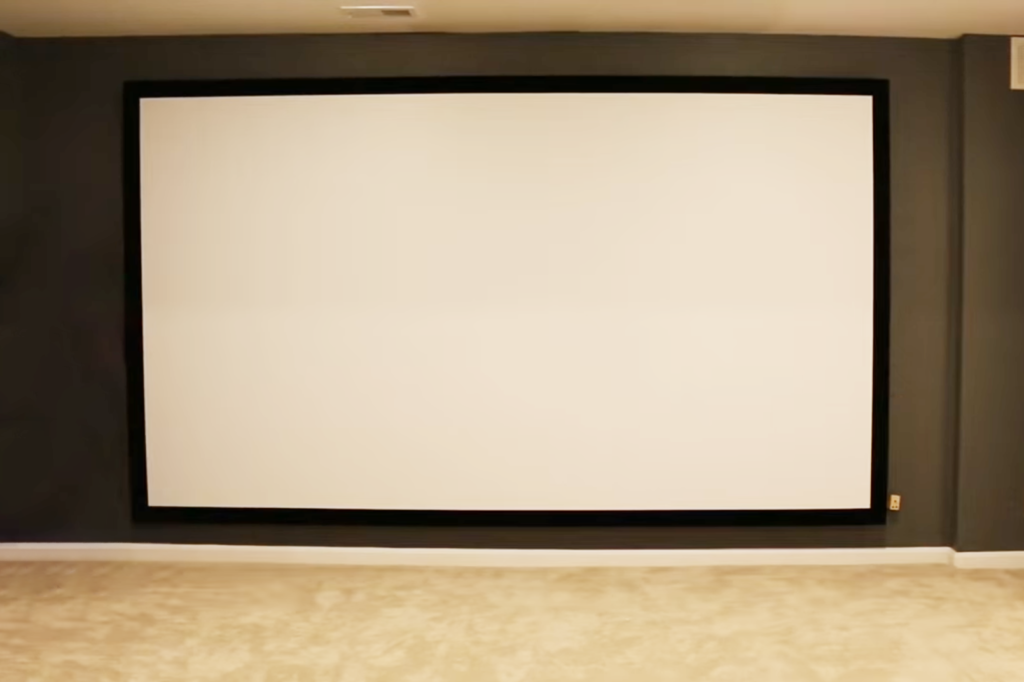
1. Projector Screen Stand
If you want a projector screen that you can take with you wherever you go, then a stand is the way to go. These come in a variety of sizes and styles, so you should be able to find one that fits your needs. Keep in mind that they will need to be set up each time you use them, so they might not be the best option if you’re looking for something that’s truly “set it and forget it.”
One popular type of projector screen stand is the tripod. These are great because they’re lightweight and easy to transport, but they can be a bit wobbly if they’re not set up correctly.
For mounting it without drilling, you have a few options. You could use adhesive strips or furniture straps. Adhesive strips come in different sizes and strengths, while furniture straps loop around the legs of furniture. If you have a heavy screen, keep in mind that adhesive strips might not provide enough support.
A rolling screen is a good option if you need to move the screen around frequently. Whichever type of stand you choose, make sure that it can support the weight of your projector screen so it doesn’t topple over during a presentation.
2. L-Shaped wall hangers
These are a popular option for those who don’t want to put any holes in their walls. All you need is two L-shaped brackets and some screws, and you’re good to go! These can be placed at the top corners of your screen and screwed into the wall.
Another thing to keep in mind is that L-shaped brackets can sometimes create a gap between the wall and the screen. To avoid this, make sure the legs of the bracket are long enough so that they sit flush against the back of the screen.
3. Using Hardwall Hangers
Hardwall hangers are one of the most popular ways to mount a projector screen without drilling. All you need is two hangers and some screws, and you can be up and running in no time!
The first step is to find a stud on your wall. You’ll want to use a stud finder to make sure you don’t drill into something that might cause damage. Once you’ve found a stud, mark it with a pencil so you know where to drill your holes.
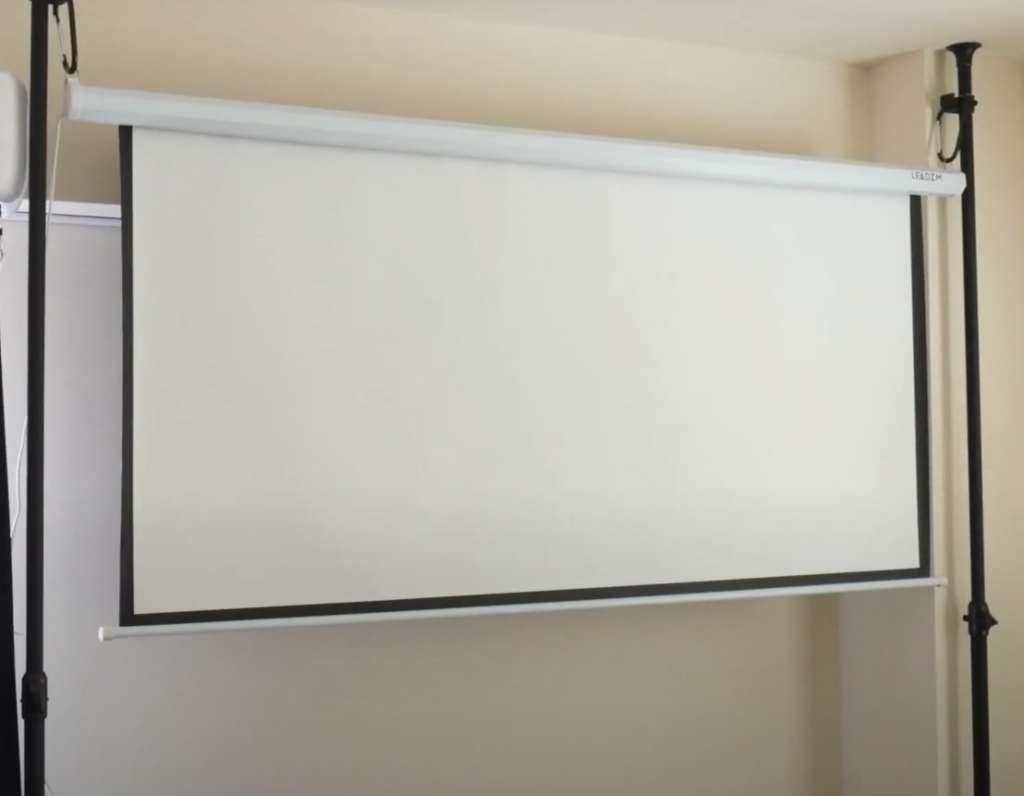
Now it’s time to drill! Drill two holes at the top of your screen, making sure they’re wide enough for the hangers to fit through. Now all you have to do is screw the hangers into the wall and you’re done!
4. Using Hanging Strips
If you don’t want to put any holes in your walls, you can use hanging strips instead. All you need is a few Command strips and some velcro. You can find the full instructions here.
This method is great if you’re renting or don’t want to damage your walls, but it’s not the most stable option. If you have kids or pets that like to run around, they might accidentally knock down your screen.
5. Brick Clamps
If you don’t want to damage your brick or mortar, then brick clamps are a great option. They work by attaching to the bricks on either side of your window and then holding the screen in place.
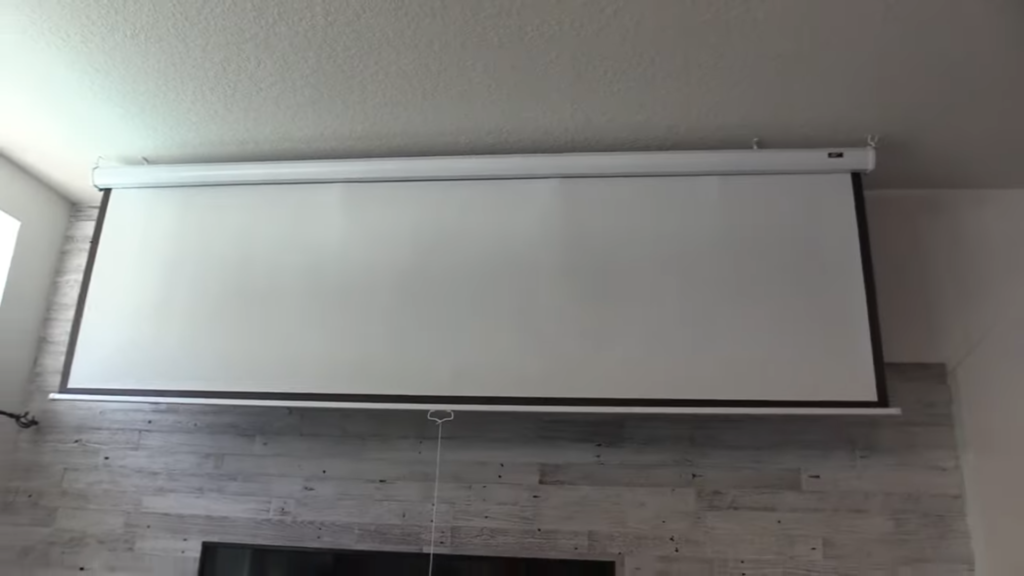
You can find brick clamps at most hardware stores, and they’re relatively inexpensive. Make sure to get the right size for your particular window.
6. Command hooks
Command hooks are also a popular way to mount a projector screen without drilling. These come in different sizes and hold strongly to most surfaces, making them ideal for larger or heavier screens. Just be sure to test the hook on your chosen surface before proceeding with the installation.
To use command hooks, start by removing the adhesive backing and pressing the hook firmly into place. Once it’s secure, loop the screen’s mounting strap around the hook and pull tight. You may need to adjust the position of the hook until you find the perfect balance between stability and tension on the screen.
For an added level of security, you can use two command hooks side-by-side or opt for a model that comes with an integrated plate for extra support. Just keep in mind that command hooks are not recommended for use on painted walls or other delicate surfaces.
Where to mount the projector screen?
There are a couple of things to think about. The first is the size of the screen. If you have a large screen, you’ll need to ensure that it will fit in the space you have available. The second is the height of the ceiling. Make sure that the screen is high enough so that people won’t be looking up at it while they’re trying to watch a movie. And finally, you’ll want to ensure that there’s enough clearance around the screen so that people can walk by without hitting their heads on it.
Once you’ve chosen a spot for your projector screen, the next step is to figure out how to mount it. There are a few different ways to do this, but the most common is to use wall mounts. Wall mounts are easy to install and they provide a lot of flexibility in terms of where you can put your screen. Another option is to use ceiling mounts, which are great if you have high ceilings. Ceiling mounts are more difficult to install, but they’re much less likely to be knocked over by accident.
Once you’ve decided how you’re going to mount the projector screen, the next step is to actually do it. If you’re using wall mounts, the first thing you’ll need to do is find the studs in your wall. Once you’ve found the studs, mark them with a pencil so that you know where they are. Then, using a drill, screw the wall mounts into the studs. Be sure to use screws that are long enough to go all the way through the mount and into the stud.
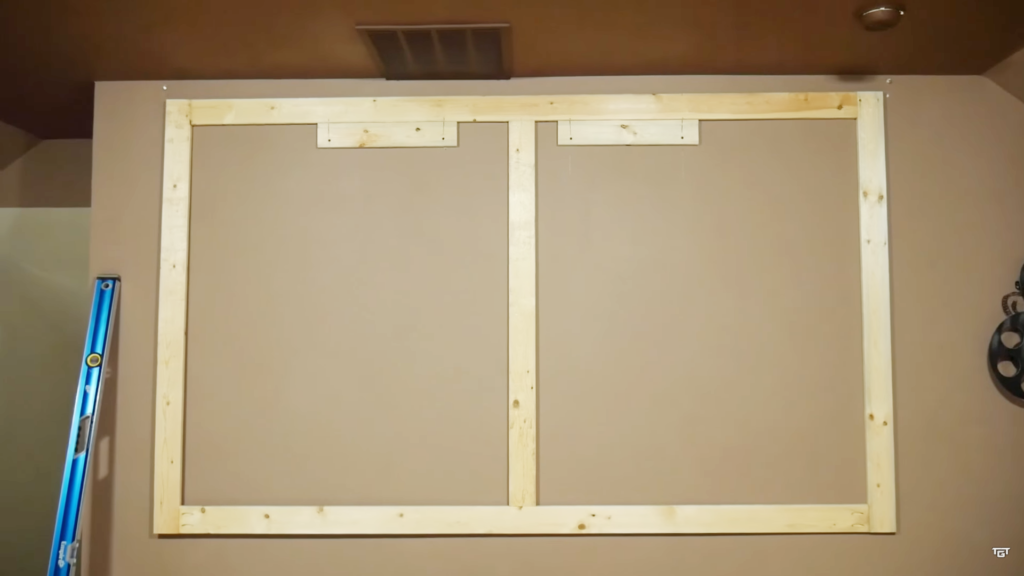
If you’re using ceiling mounts, the process is similar. The first thing you’ll need to do is find the joists in your ceiling. Once you’ve found the joists, mark them. Then, using a drill, screw the ceiling mounts into the joists. [1]
Once you’ve mounted your projector screen, it’s time to test it out. First, turn off all the lights in the room. Then, projected an image onto the screen. If everything looks good, you’re ready to start watching movies! If not, ensure that the projector is properly aligned and that there’s nothing blocking the path of the beam.
Things to know before mounting projector screen
The first is that you’ll need to find the right mounting brackets. There are a variety of brackets available, so it’s important to find the ones that will work best for your particular setup.
The second thing to keep in mind is that you’ll need to be careful when handling the screen. It’s important not to damage the screen while you’re mounting it. [2]
FAQ
Can you mount a projector without drilling?
You can, but it’s not as secure. We recommend drilling into the surface for a more stable hold.
If you absolutely cannot drill into your wall or ceiling, there are a few ways you can still mount your projector screen. One way is to use command strips designed for heavy objects. Another way is to build a frame out of wood that you can then attach to the wall with screws or nails.
Neither of these methods is as secure as drilling, so keep that in mind if you go this route. [3]
How do you hang a projector without holes?
There are a few ways that you can hang a projector screen without making holes in your wall. The first option is to use adhesive hooks. Adhesive hooks are a great way to hang a projector screen because they are easy to remove and won’t damage your walls. Another option is to use tension rods. Tension rods are also easy to remove and won’t damage your walls, but they may not be as secure as adhesive hooks.
For a more permanent solution, you can always drill into your wall. Drilling into your wall will give you the most secure mount for the projector screen, but it will also require the most work. If you’re not comfortable drilling into your wall, you can always hire a professional to do it for you. [4]
How do you stick a projector screen to the wall?
There are a few ways that you can stick a projector screen to the wall without drilling. One way is to use adhesive strips. Adhesive strips are available at most hardware stores and come in different sizes. Another way is to use furniture sliders. Furniture sliders are small, round disks that have an adhesive back. You can find them at most hardware stores or online. Finally, you can also use command hooks. Command hooks are large plastic hooks that come with an adhesive strip on the back. They are available at most hardware stores or online.
Can you mount a projector screen on drywall?
You can, but it’s not ideal.
If possible, try mounting the screen on wood paneling instead. This will provide much more support and stability than drywall alone. You can find wooden paneling at most home improvement stores. Simply cut it to size with a saw and then screw it into place using washers and screws similar to what you would use on drywall. [5]
Another option is to use a product called Toggle Bolts. These are specialized screws that have wings that open up once they’re inside the wall. This provides a very strong hold, making them ideal for mounting projector screens (or anything else, for that matter). They can be a bit more difficult to install than other methods, but if you’re confident in your DIY skills, they’re definitely worth considering.
Useful Video: DIY Home Theater for Your Apartment! | RENTER FRIENDLY| AFFORDABLE
Conclusion
As you can see, there are various ways to mount a projector screen without drilling. Weigh the pros and cons to decide which method is ideal for you. With a little effort, you can have your screen mounted in no time! This concludes our article. We hope you found it informative and helpful. Thanks for reading!
References
- https://technoqia.com/how-to-mount-a-projector-screen-without-drilling-wall/
- https://www.wikihow.com/Mount-a-Projector
- https://projectorninja.com/how-to-mount-a-projector-without-drilling/
- https://rankprojectors.com/how-to-mount-a-projector-without-drilling/
- https://projectortime.com/how-to-mount-a-projector-screen-on-drywall/


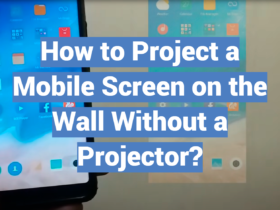


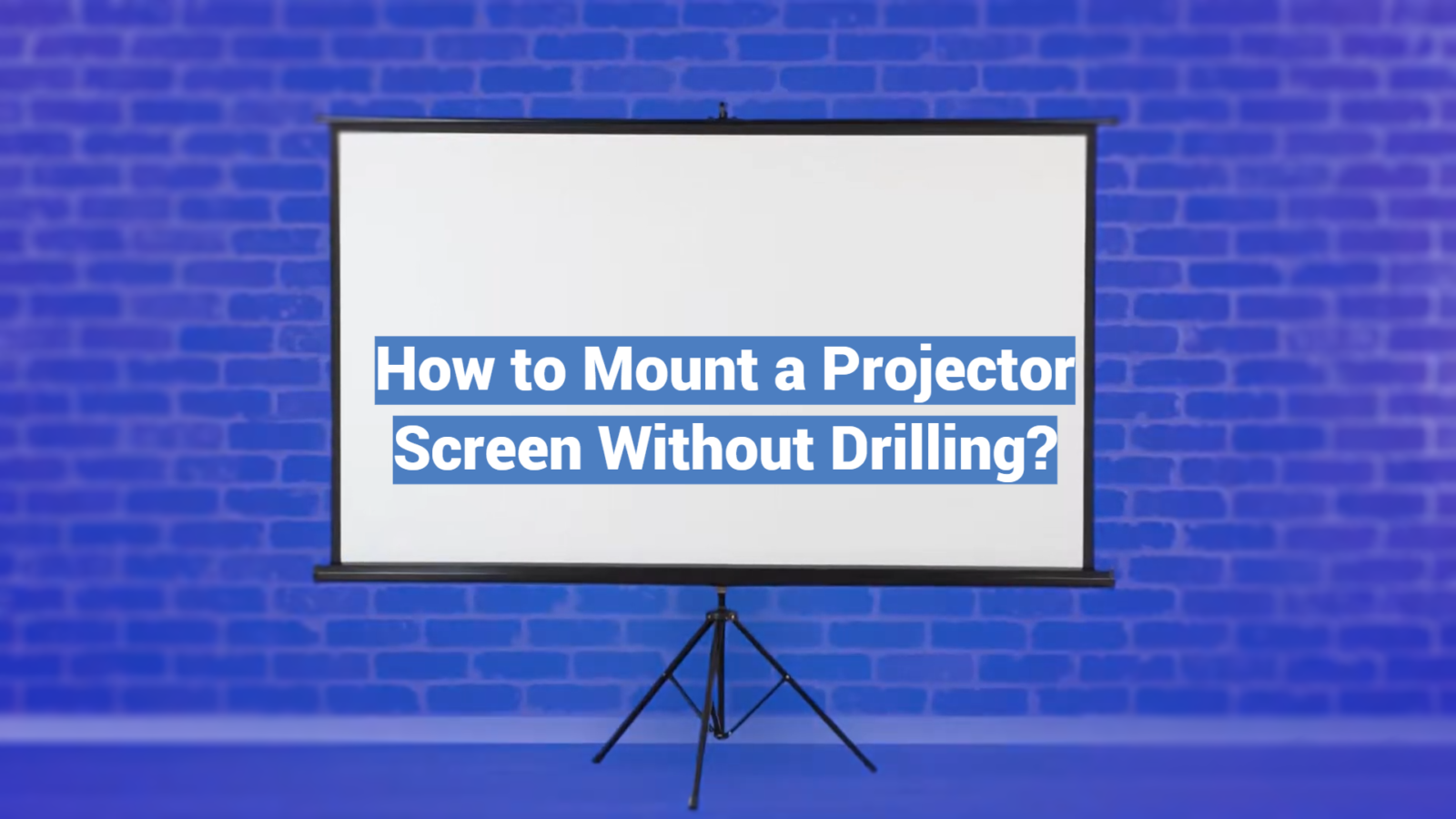
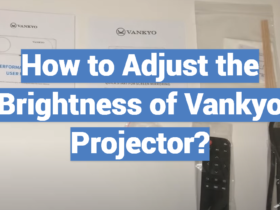



Leave a Review